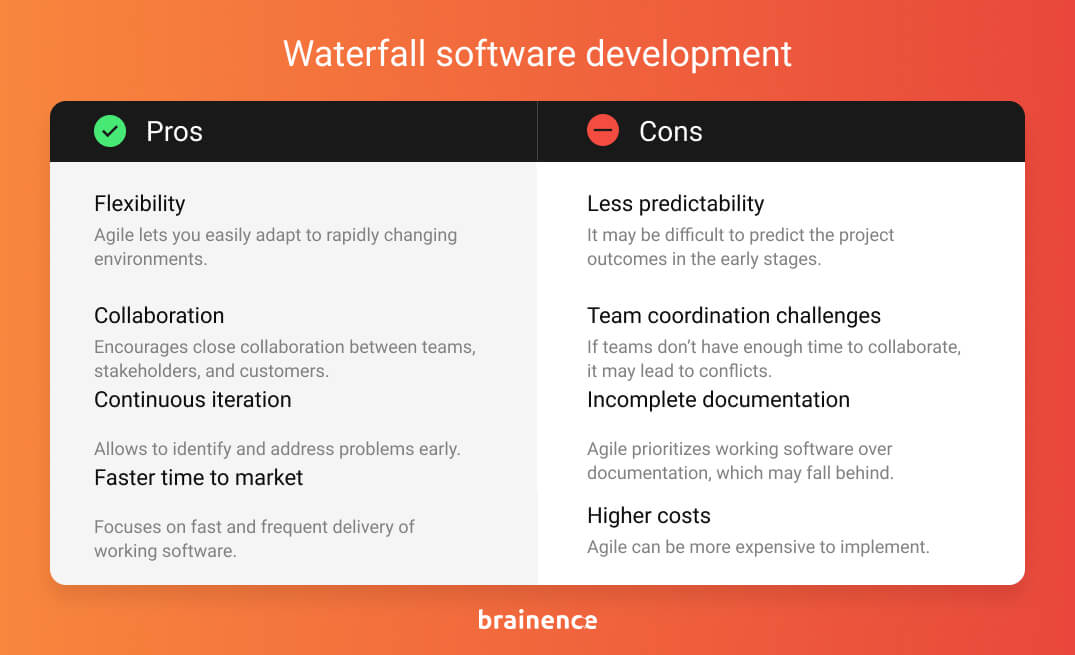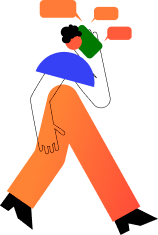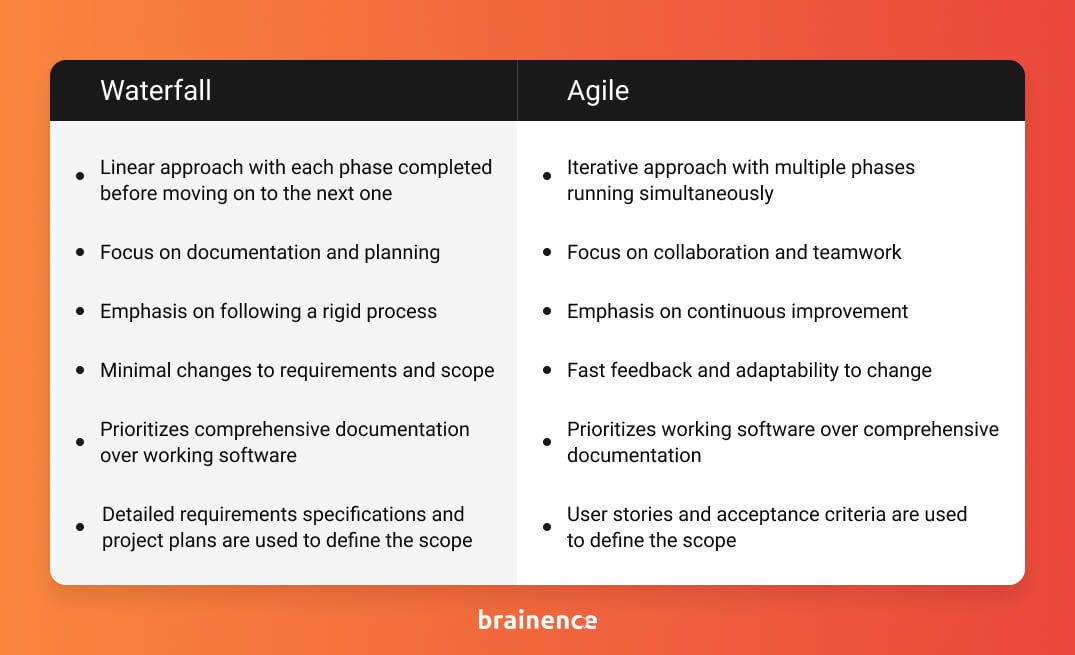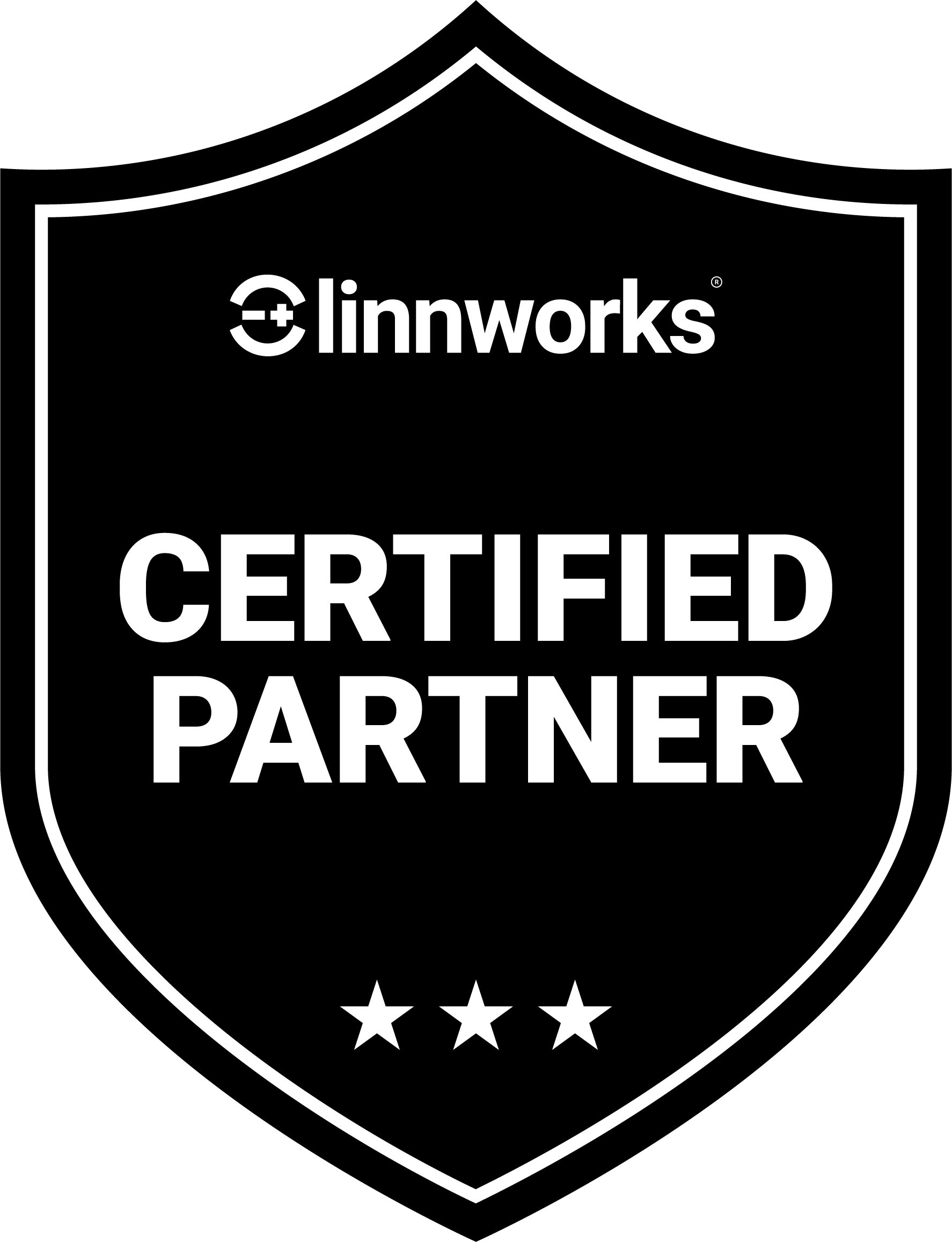25 April 2023
Agile vs. Waterfall methodology: Which is the best fit for your project?
When discussing the Agile vs. Waterfall methodology, selecting the right software development approach can make or break the project. With this article, you’ll learn the pros and cons of each methodology and decide which aligns with your business goals best.

Solutions
Author
|Contributor

Romanna Pastyrska
Writer
Ivan Dochynets
Co-founder, Chief Technical OfficerAgile vs. Waterfall methodology is a common debate. While Waterfall has been the traditional approach for many years, Agile has gained significant popularity due to its flexibility and adaptability.
The main difference between the two approaches is that Waterfall requires the team to complete each phase before moving on to the next. At the same time, Agile allows working on different phases of the project simultaneously.
At Brainence, we use the Agile methodology to deliver software, but we are also familiar with Waterfall. And we are willing to help you understand both methodologies better.
We asked Ivan Dochynets, our Chief Technical Officer, to share his knowledge and contribute an in-depth analysis of each model to help decide on the Agile vs. Waterfall methodology discussion.
Read on to figure out which software development methodology will work best for your project and team.
What is Waterfall?
The Waterfall methodology is a step-by-step, linear process of project management involving a series of distinct phases.
Each project phase flows seamlessly into the next, like water cascading over a cliff.
In the Waterfall model, each phase must be entirely completed before the team moves on to the next stage. To make changes, you have to start the process over again from phase one.
The strict approach of the Waterfall can be attributed to its origins. It was not initially designed for software development and was more suited to fields like manufacturing or construction, where changes are not easily accommodated.
Phases of Waterfall software development
Here’s the list of the general phases that the Waterfall approach includes:

1. Requirements gathering
To kick off the project, you must gather and document all the requirements by conducting interviews, surveys, questionnaires, and brainstorming sessions.
2. Design
The team decides how to build the product that can solve the project’s requirements. This stage covers hardware and system requirements, including programming languages, network infrastructure, user interface, etc.
3. Implementation
During this stage, the design requirements are turned into functional and readable code. This stage is slightly flexible, allowing developers to implement the code at the start of the next phase rather than completing it during the implementation phase.
4. Testing
When the coding is finished, quality assurance engineers identify and report issues on the platform. If any significant issues arise, the team may need to return to the first phase.
5. Delivery
When the team ensures the product works well, it can submit deliverables to be deployed or released.
6. Maintenance
After the team delivers the project to the client, new issues may arise. The team may create patches or updates when needed. If you get a more serious issue, the team can return to phase one to solve the problem.
Pros and cons of Waterfall software development
Waterfall software development comes with its own set of benefits and drawbacks, so let’s take a closer look at them.

Pros:
- Clear framework. Waterfall provides you with a set of phases to follow, requirement gathering and documentation, design, implementation, testing, delivery, and maintenance.
- Predictable outcomes. The Waterfall approach can provide predictable outcomes, as each phase of the project is completed before moving on to the next phase, which can help to minimize the risk of surprises or unexpected issues arising.
- Well-defined goals. The Waterfall approach involves well-defined milestones and deliverables, which can help to keep the project team focused and motivated.
- Easy to manage. Waterfall-based projects are well-defined and predictable, which makes Waterfall one of the easiest models to manage.
Cons:
- Lack of flexibility. Almost every need for revision and changes makes the team return to phase one and rethink the requirements. Also, some projects start as an idea that needs further clarification as the project continues, which Waterfall does not allow.
- Lengthy delivery time. The development process can take more time, as each phase needs to be entirely completed before moving on to the next phase.
- Limited collaboration. The Waterfall approach typically involves a hierarchical structure, where each team works on separate tasks in isolation. This can cause communication problems between teams and lead to problems.
- Risk of budget overruns. Due to the rigid nature of the Waterfall approach, any changes to the project scope or requirements can result in additional costs, leading to budget overruns.
It’s worth noting that not all of these pros and cons can be applicable to every project that uses the Waterfall methodology, as the success of a project depends on a variety of factors, including the project team, scope, and goals.
Waterfall is often contrasted with Agile methodologies, which prioritize flexibility and iterative development over a rigid, linear process.
Build your product quickly and efficiently
Brainence has 6+ years of experience delivering impactful software development solutions fast and within budget. Contact us to get a quote for your project.

What is Agile?
Agile methodology is a project management framework that enables teams to deliver working software faster and with fewer challenges.
Unlike the Waterfall model, Agile software development and testing go side by side and imply communication between customers, developers, managers, and testers.
An agile mindset is based on collaboration with clients and the entire team. If used correctly, it can lead to a better software development experience, in which the team is a living organism with iterations, communication, and a place for a change in uncertainty.
Core values of Agile
The guiding principles of Agile are reflected in Agile Manifesto. Written in 2001 by a group of software experts frustrated by the traditional approach, it has become a cornerstone of Agile methodology.
The four core values of Agile declared in the Manifesto are:
- Individuals over processes and tools. Agile teams prioritize collaboration over working independently and following rigid procedures.
- Working software over comprehensive documentation. The quality of the software is of utmost importance, while documentation is considered secondary.
- Customer collaboration over contract negotiation. Customer collaboration is highly valued in Agile methodology, as customers play a critical role in determining the project’s direction. Contract negotiation is less important in comparison.
- Responding to change over following a plan. Responding to change is a critical aspect of Agile methodology, which enables teams to deliver high-quality results in a rapidly changing environment.
Since the publication of the manifesto, many Agile frameworks have been developed and adopted. These include Scrum, Kanban, Lean, and Extreme Programming (XP).
Pros and cons of Agile software development
What are the reasons behind Agile’s popularity? Let’s take a closer look at its advantages and disadvantages.

Pros:
- Flexibility. The software development life cycle in Agile is never linear. Agile lets you adapt planned sprints when the team gets a better idea of what they need from the software, which can be especially valuable in dynamic and rapidly changing environments.
- Collaboration. Agile encourages close collaboration between team members, stakeholders, and customers, which fosters a productive and trustworthy working environment.
- Continuous iteration. The Agile approach emphasizes continuous improvement, which can help to identify and address problems early and ensure that the project stays on track.
- Faster time to market. The Agile approach focuses on fast and frequent delivery of working software, which can help to reduce time to market and provide faster feedback to stakeholders.
Cons:
- Less predictability. Using Agile, you may not be able to predict the project outcomes or profits in the early stages.
- Team coordination challenges. If teams that run different project phases don’t communicate enough or don’t have enough time to collaborate on tasks, it may lead to conflicts.
- Incomplete documentation. Agile methods often prioritize working software over comprehensive documentation, making it more difficult to maintain and support the software over time.
- Higher costs. The software development life cycle in Agile can be more expensive compared to other development methodologies.
Agile vs. Waterfall methodology: a detailed comparison
You can find a high-level difference between the Agile and Waterfall methodologies below.

The traditional Waterfall approach to software development involves following a predefined plan that is inflexible and unable to accommodate changes. This often results in diminished business value for the client.
When compared with Waterfall, Agile methodology is an iterative process that involves customer collaboration. Its flexibility allows for changes to be made easily.
Waterfall methodology vs. Agile: what methodology should you choose for your project?
When comparing Agile methodology vs. Waterfall, keep in mind your project requirements.
If your project is predictable and the team working on it is small, using the Waterfall methodology can be an effective framework to ensure team organization and progress.
While Waterfall is fixed and more rigid, the Agile method is adaptable and is better suited for a client-facing work process.
Even though Agile is a more popular tool nowadays, it doesn’t mean it’s a great fit for every project. In fact, Agile is more suitable for larger, more complex projects.
It’s called “Agile” for a reason: the model is easily adjusted, and it fits projects with constantly changing requirements. Thanks to these features, this methodology won the heart of most development organizations, overshadowing the Waterfall model.
Nowadays, projects rarely choose to work with a Waterfall: it doesn’t adapt to the needs well, has managing requirements issues, which wastes lots of time.
Hire the best Agile software development talents
If you’re looking for an Agile software development partner, we can help. Contact us to discuss your project needs, and we’ll provide you with the best Agile team available.

Can Waterfall and Agile be combined?
If you believe your project can benefit from both approaches, you can try the hybrid model in which Agile and Waterfall are combined.
For instance, you can use Waterfall type analysis and design initially but then follow by Scrum as a production method. This way, you get an overview of a complete project, but you proceed with the development phase with constant feedback based on the feedback you receive from users or the client.
The hybrid approach will bring the desired flexibility while allowing you to get a clear picture upfront.
We hope this article has helped you to decide between Agile methodology vs. Waterfall and you now have a clear image of what you’ll get from both models to move on.
Searching for a reliable software development partner?
Now that you have a better understanding of what software development methodology you need, you can set more clear demands for your future software development vendor.
What methodology do they follow? Are they capable of delivering the product fast? Will you, as a client, be engaged in the project, and to what extent? Those questions (and many more) must be clarified as you meet your potential partner for the first time.
Brainence is a software development company with 6+ years of experience scaling Agile teams and building powerful products. We have helped over 70 companies build high-quality products on time and within budget.
Contact us to discuss your project in detail during a free consultation.
Contact us

The most impressive for me was the ability of the team to provide first-class development and meet all the deadlines.

The team proactively comes up with solutions and is eager to deliver high-quality development support.

I was blown away by the knowledge that Brainence has about web app development, UX and optimisation.

